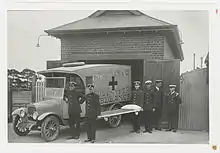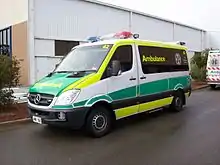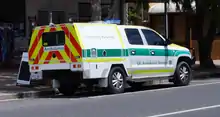SA Ambulance Service
SA Ambulance Service (SAAS) is a State Government agency under SA Health, that provides emergency ambulance transport, clinical care and non emergency patient transport services to over 1.5 million people, distributed across an area of 1,043,514 square kilometres in South Australia, Australia.
 | |
| Agency overview | |
|---|---|
| Jurisdiction | Government of South Australia |
| Employees | 2,500+ |
| Agency executive |
|
| Parent agency | SA Health |
| Website | www.saambulance.com.au |
The service employs approximately 1600 people, and utilizes 1400 volunteers, working out of 105 locations, operating 385 ambulance vehicles to provide emergency, non-emergency, aeromedical, rescue and retrieval services across the entire state.
History

In 1949 the metropolitan area was served by:[1]
- SA Ambulance Transport Inc. (originally Hindmarsh Volunteer Ambulance formed in 1921), seven vehicles based at Hindmarsh, Unley (from March 1931 on behalf of Unley City Council[2]) and Port Adelaide (started in July 1922 as Port Adelaide Citizen's Ambulance[3])
- Civil Ambulance (Police Department) two vehicles based at Angas St, Adelaide
- Northern Suburbs Ambulance Association, one vehicle based at Prospect since 1 January 1947[4]
- Joe Myren's Private Ambulance, one vehicle based at Glen Osmond Road, Parkside since June 1927[5]
 Joe Myren's Private Ambulance 1927
Joe Myren's Private Ambulance 1927
In a ceremony at the St. John Ambulance Brigade annual review on Sunday 21 September 1952[6] metropolitan ambulance services in Adelaide (and later the country services) were formally merged to run by the St. John Council for South Australia Inc. which was part of St John Ambulance until 1993. Joe Myren's Private Ambulance was not merged[7] immediately and continued to run independently until 1955 when the business and vehicle were sold to St. John for £500.[8]
Through to the 1980s, the ambulance service in metropolitan Adelaide was staffed by volunteers at nights and weekends. After a series of industrial disputes from 1977 and parliamentary enquiries through the 1980s the service moved to a fully paid service in the metropolitan area by 1991[9] as well as major country centres, representing a huge shift in public opinion from the strong support of volunteerism in 1979.[10]
SAAS came into being in 1993 as a result of the Ambulance Services Act 1992 which formed an association S.A. St. John Ambulance Service Inc as a joint venture between the Minister of Health and Priory in Australia of the Grand Priory of the Most Venerable Order of the Hospital of St. John of Jerusalem.[11] The name of the association was amended to SA Ambulance Service Inc in 2005[12] and in 2008,[13] SAAS became an agency under the Minister of Health.
Ambulance types
SA Ambulance Service is known to operate a variety of emergency and non-emergency vehicles across the state, which travel in excess of 10 million kilometres each year.
All vehicles have distinctive livery, high visibility LED lightbar and warning lights and sirens. Recently introduced new design livery has improved visibility and safety.
Emergency Ambulances


Mercedes Sprinter 318 Vans operate around metropolitan areas whereas country areas use a variety of Mercedes Sprinter 316, 315 and 318 Vans and Toyota Landcruiser Troopcarriers. All emergency ambulance crews rostered within the Adelaide metropolitan area are skilled at least Paramedic level (3-year degree + 1-year internship) with numerous crews skilled at Intensive Care Paramedic level (3-year degree + 1-year internship + 2 years paramedic experience as a minimum + graduate diploma + an ICP internship). In rural areas of South Australia approximately 1,500 Ambulance volunteers crew emergency ambulances and community response vehicles (station wagons/4 wheel drives). SAAS Clinical Education unit (a Registered Training Organisation) trains volunteer Ambulance Assists & Ambulance Responders to Nationally accredited Certificate II in Medical Service First Response and Ambulance Officers to Certificate IV in Health Care Level. SAAS is the only emergency ambulance provider in South Australia.
Patient Transport Service
Mercedes Benz Sprinter 315 and 318 vans have replaced Ford Transits for use by both the Patient Transport Service (PTS) and Emergency Support Service (ESS) crews. These vehicles do not carry the same equipment as standard emergency ambulances but are equipped at Basic Life Support level. PTS and ESS Ambulance Officers are trained via the SAAS Clinical Education unit (a Registered Training Organisation) To the Nationally Accredited Certificate IV in Health Care qualification.
Extended Care Paramedics
SAAS also operate a team of Extended Care Paramedics,[14] who operate from Mercedes Vito vans. Unlike regular paramedics, ECPs are able to treat patients for common medical issues, and refer to other health providers such as GPs if needed, reducing the need to transport patients to hospital emergency departments unnecessarily.
SPRINT (Single Paramedic Response and INTervention)
SPRINT Paramedics[15][16] use Volkswagen Tiguan Allspace 162TSI [17] vehicles for rapid response purposes within the Adelaide metropolitan area.
SPRINT Bicycles (BRU)
SPRINT paramedics[15] also utilise bicycles at major events where heavy pedestrian traffic may reduce response times for larger vehicles. The crews may be used to help guide ambulances through busy areas, and carry limited medical equipment including oxygen and a defibrillator.
Management & Operational Command Vehicles
SAAS use a mix of Holden Trailblazer and Colorado vehicles for Team Leaders and Managers. The Special Operations Team use two Toyota Landcruiser 4WD vehicles (Fleet 402 and (412) and a purpose built Mercedes Sprinter 518 rescue support vehicle (Fleet 302) when performing the SOT responder role. An Isuzu 16 tonne Tactical Support Vehicle (Fleet 303) and a VW Kombi van are used as command vehicles for major incidents and planned events.
Airwing
SAAS are the controlling authority for the five Babcock Rescue Helicopters (1 EC 130 and 4 Bell 412), for the use of roadside trauma response, medical retrievals, training exercises and SAPOL, CFS and SES operations. The Royal Flying Doctor Service operate a number of Pilatus PC12 aircraft performing inter-hospital transfers from regional area and first response ambulance service in remote areas.
Special Operations Team
Special Operations Team (SOT) rescue paramedics are trained in high-risk rescue procedures. They work closely with other emergency services and the South Australian Police STAR Group. SOT Paramedics also cycle through the MedSTAR retrieval service.
Communications
The SAAS Emergency Operations Centre (EOC), based in Eastwood, Adelaide, primarily answers emergency triple-zero (000) calls using the MPDS dispatch system. The EOC coordinates SA Ambulance Service resources. The EOC also coordinates the dispatch of the Motor Accident Commission Rescue Helicopter Service and MedSTAR Retrieval Service. Emergency medical dispatch support officers (EMDSO) coordinate calls from the Divers Emergency Service and the SA Trauma Service.
Communications between paramedics and the EOC is conducted primarily through Mobile Data Terminals[18] and SA GRN pagers and radios, but mobile phones may also be used in some circumstances.
See also
References
- Blake Brownrigg (15 November 1949). "We've been lucky so far but it's time to overhaul ... Adelaides's haphazard ambulance service". The News. Adelaide: National Library of Australia. p. 4. Retrieved 30 October 2013.
- "UNLEY AMBULANCE". Advertiser and Register (Adelaide, SA : 1931). Adelaide: National Library of Australia. 31 March 1931. p. 10. Retrieved 15 December 2013.
- "PORT ADELAIDE MOTOR AMBULANCE". The Advertiser. Adelaide: National Library of Australia. 29 July 1922. p. 9. Retrieved 15 December 2013.
- "NORTHERN SUBURBAN FREE AMBULANCE". The Advertiser. Adelaide: National Library of Australia. 1 January 1947. p. 4. Retrieved 30 October 2013.
- "STUDEBAKER AMBULANCE". The Advertiser. Adelaide: National Library of Australia. 28 July 1927. p. 17. Retrieved 30 October 2013.
- "New Task For St. John Ambulance". The Advertiser. Adelaide: National Library of Australia. 22 September 1952. p. 3. Retrieved 30 October 2013.
- "POINTS FROM LETTERS". The Advertiser. Adelaide: National Library of Australia. 23 September 1952. p. 4. Retrieved 30 October 2013.
- Howie-Willis, Ian; Fegan, Beryl (1985). South Australians and St. John Ambulance, 1885-1985: the centenary history of the Order of St. John in South Australia. Adelaide: St. John Council for South Australia. p. 244. ISBN 0959287418.
- "St John volunteers close shop". The Advertiser. Adelaide: News limited. 7 May 1991. p. 10. Retrieved 28 May 2019.
- Cornwall, John (1989). Just for the Record: The Political Recollections of John Cornwall. Adelaide: Wakefield Press. pp. 60–63. ISBN 9781862542563.
- Ambulance Services Act 1992 Archived 17 March 2011 at the Wayback Machine
- Ambulance Services (SA Ambulance Service Inc) Amendment Bill 2005 (SA)
- Health Care Act 2008 (SA) s 49
- "About Us".
- "About Us".
- Archived at Ghostarchive and the Wayback Machine: SA Ambulance Service Sprint Cars video. YouTube.
- "Sprinting to the aid of patients". June 2020.
- "20-minute suburbs: Australia's walking-friendly cities". 25 March 2019.
Further reading
- Woods, Glen, ed. (2012). Two pennies and a piece of wire. Personal glimpses of the first 60 years of organised ambulance service in South Australia: 1952-2012. Adelaide: SA Ambulance Service Retired Officers' Association Inc. p. 64. ISBN 9780646569581.
Take a wild ride back in time to the 1950s with eight retired ambulance officers as your irreverent tour guides.